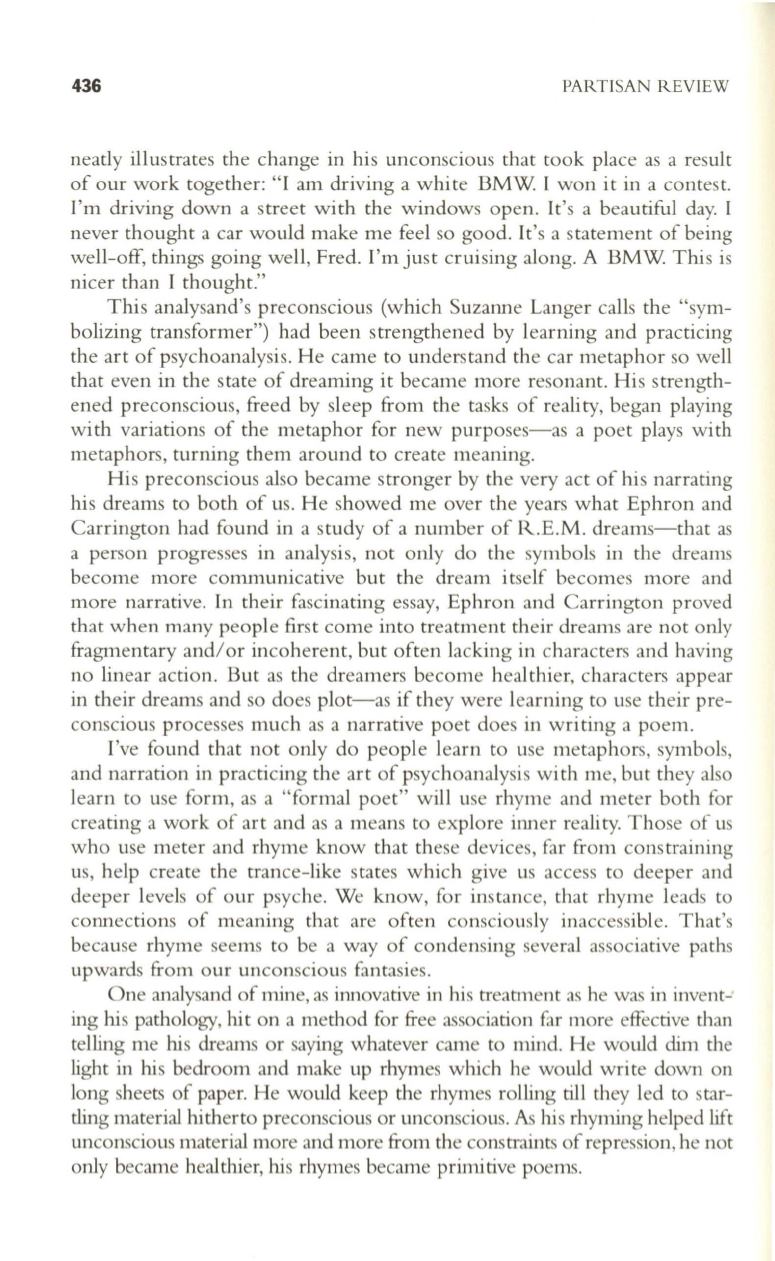
436
PARTISAN REVIEW
neatly illustrates the change in his unconscious that took place as a result
of our work together: "I am driving a white BMW I won it in a contest.
I'm driving down a street with the windows open. It's a beautiful day. I
never thought a car would make me feel so good. It's a statement of being
well-off, things going well, Fred. I'm just cruising along. A BMW. This is
nicer than I thought."
This analysand's preconscious (which Suzanne Langer calls the "sym–
bolizing transformer") had been strengthened by learning and practicing
the art of psychoanalysis. He came to understand the car metaphor so well
that even in the state of dreaming it became more resonant. His strength–
ened preconscious, freed by sleep from the tasks of reality, began playing
with variations of the metaphor for new purposes-as a poet plays with
metaphors, turning them around to create meaning.
His preconscious also became stronger by the very act of his narrating
his dreams to both of us. He showed me over the years what Ephron and
Carrington had found in a study of a number of R.E.M. dreams-that as
a person progresses in analysis, not only do the symbols in the dreams
become more communicative but the dream itself becomes more and
more narrative. In their fascinating essay, Ephron and Carrington proved
that when many people first come into treatment their dreams are not only
fragmentary and/or incoherent, but often lacking in characters and having
no linear action. But as the dreamers become healthier, characters appear
in their dreams and so does plot-as if they were learning to use their pre–
conscious processes much as a narrative poet does in writing a poem.
I've found that not only do people learn to use metaphors, symbols,
and narration in practicing the art of psychoanalysis wi th me, but they also
learn to use form, as a "formal poet" will use rhyme and meter both for
creating a work of art and as a means to explore inner reality. Those of us
who use meter and rhyme know that these devices, far from constraining
us, help create the trance-like states which give us access to deeper and
deeper levels of our psyche. We know, for instance, that rhyme leads to
connections of meaning that are often consciously inaccessible. That's
because rhyme seems to be a way of condensing several associative paths
upwards from our unconscious fantasies .
One analysand of mine, as innovative in his treatment as he was in invent–
ing his pathology, hit on a method for free association far more effective than
telling me his dreams or saying whatever came to mind. He would
dim
the
light in his bedroom and make up rhymes which he would write down on
long sheets of paper. He would keep the rhymes rolling till they led to star–
tling material hitherto preconscious or unconscious. As his rhyming helped lift
unconscious material more and more from the constraints of repression, he not
only became healthier, his rhymes became primitive poems.


